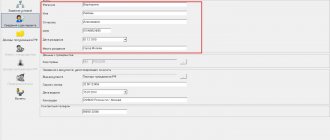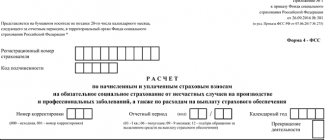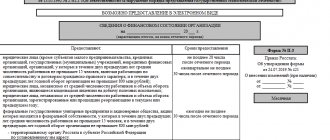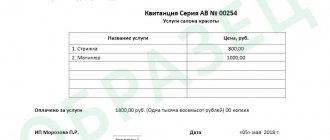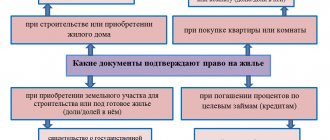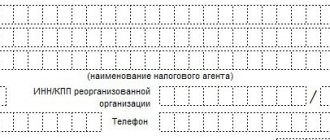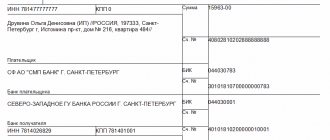Items used for work, like any equipment, become unusable. To exclude them from the organization’s property, it is necessary to carry out a write-off procedure. For government institutions, Order No. 52n of the Ministry of Finance of Russia dated March 30, 2015 applies, which regulates, among other things, the forms of documents required for disposal. The sample act for writing off materials for production depends on the type of property being written off. There are:
- act on write-off of inventories;
- act on the disposal of soft and household equipment.
The sample act for writing off inventory differs not only in the type of asset, but also in the form of the form.
Basis for compilation
The basis for compilation may be:
- an inventory was carried out, during which it became clear that some of the accounting objects needed to be disposed of;
- initiative of persons responsible for the use of values (PRO).
The reason for writing off materials in the write-off act depends on what kind of material assets are supposed to be written off. For example, the disposal of soft equipment may be due to the wear and tear of the item, stationery must be transferred according to a statement from the MOL to the direct user (statement for issuing valuables for the needs of the institution according to form 0504210), dishes are entered according to the tableware breakage registration book (form code 0504044). In case of destruction of inventory items, approved documents must be attached.
Responsible persons are members of the commission for the receipt and disposal of assets. They are appointed by order of the head of the institution.
Material recycling act form C-7
A situation often arises when an enterprise has some specific components on its balance sheet. But there is a need to make certain materials from them. In this case, it becomes necessary to draw up a processing act, which indicates the characteristics of the received material, notes the presence of defects, etc. Naturally, signatures in the document are affixed after a thorough inspection of the material and determination of the clear amount of materials intended for processing.
Sample
Useful: how to write off inventory items for production or sale
Accounting and tax accounting for the write-off of inventory items (material assets) depends on the type of these assets and the grounds for their write-off (disposal).
Inventories include inventories (MPI), as well as finished products (clause 2 of the Accounting Regulations “Accounting for inventories” PBU 5/01, approved by Order of the Ministry of Finance of Russia dated 06/09/2001 N 44n (hereinafter referred to as PBU 5/01), clause 3.15 of the Guidelines for the inventory of property and financial obligations, approved by Order of the Ministry of Finance of Russia dated June 13, 1995 N 49). Read more in ConsultantPlus
Act of writing off materials that have become unusable
There are a huge number of reasons why materials can lose their original characteristics. Naturally, they are not suitable for further use. This may be the fault of those responsible, or natural wear and tear. If expensive materials are written off, such a decision can be made by the director, chief accountant, or head of the department. The fact that the materials are unsuitable is also confirmed by the commission members. In addition, the cost of each material and the total amount for which the write-off occurs is indicated here. It is also necessary to indicate in what quantity the material is written off. At the discretion of the inspectors, additional information can be indicated in the document. Usually there are special graphs for this.
Sample
Sample filling
Let's give a sample act of writing off material assets that have fallen into disrepair, using the example of a children's institution canteen.
Step 1. Fill in the number and date, name of the organization, structural unit, OKPO code, INN and KPP of the institution, financially responsible person, members of the commission for the receipt and disposal of assets, details of the order on the basis of which the commission operates.
Step 2. The commission, in the presence (in our case) of the canteen manager, checks whether the valuables have really become unusable, which they certify with signatures. Decides on the need to exclude from the valuables items that do not meet the requirements for them.
Step 3. After filling in all the required fields, the last sheet is filled out with the signature of the chairman and members of the commission. They can be the administrative staff of the organization, accounting workers, and other specialists.
Issued in two copies. One of them is transferred to the appropriate service in order to reflect the data in accounting. The second remains with the financially responsible person as a document confirming the disposal of the material.
How to draw up an act for writing off materials
The main feature of the document is to correctly enter all the data into it, without allowing any distortions.
For example, information about the company that has the materials on its balance sheet must be present here. In addition, all members of the created commission, their passport details and positions should be described in detail. Naturally, the commission is created after the head of the company issues a separate order. A senior specialist is selected. Particular attention should be paid to the column intended to indicate the materials being written off. If there are several of them, you can use a list for better perception. The description must be such that there are no difficulties in identifying the material. Opposite each material its cost is indicated. At the bottom of the document you should write down the total cost of all materials being written off. The reason why it was necessary to draw up this document is also noted.
In specially designated lines, each employee who is part of the commission is required to certify the document with his signature. This suggests that experts fully agree with the information provided. After this, the document is submitted for signature to the director of the company. After affixing the signatures, the act receives legal force. Based on it, accountants write off materials from the balance sheet of the enterprise. Naturally, such information is also displayed in tax accounting.
The document must have one copy. It is he who comes to the disposal of the accounting department, where it is further processed and the materials are written off from the company’s balance sheet. However, any interested party, which includes members of the commission, has the right to ask for a copy of the document for themselves. There is no urgent need to put stamps on the document. Information about the act is entered into a special journal of the enterprise, since it is an internal turnover document.
Responsibility
The commission is responsible for drawing up documents, checking materials, and establishing complete wear and tear or unsuitability of valuables.
Inventories on the company's balance sheet cannot be disposed of without drawing up the appropriate papers in the presence of members of a specially convened group, otherwise the responsible persons will be liable within the limits of their individual liability agreement.
January 11, 2021
If you need to write off inventory items that have become unusable, draw up an act of write-off of goods in the TORG-16 form. The 2020 sample filling and form are below on the page.
Get the form for free!
Register in the online document printing service MoySklad, where you can: completely free of charge:
- Download the form you are interested in in Excel or Word format
- Fill out and print the document online (this is very convenient)
The document confirms the legality of the actions of the storekeeper or other financially responsible person. Form TORG-16 is needed mainly by organizations that sell food products, pharmacies and other companies dealing with perishable goods and materials. You can download a sample of filling out the act of writing off goods TORG-16 below.
Act on write-off of materials for equipment repair
Quite often, if any equipment at an enterprise breaks down, they repair it themselves. In addition, repair work can be carried out by a contractor. Often, materials that are on the organization’s balance sheet are used for this purpose. Naturally, after repair work is completed, the materials used must be written off. In this case, a corresponding act is drawn up.
Purpose of material consumption
When filling out the act, it is recommended to indicate detailed information in this column. For example, equipment was reconstructed and modernized. This can be any other action aimed at increasing the operational life of the equipment and improving its technical characteristics. The document should indicate not only the purpose, but also the specific materials that were used in this repair.
Sample
Related documents
- Act report on the consumption of alcohol from the warehouse
- Books of accounting of income and expenses of organizations and individual entrepreneurs using a simplified taxation system
- Payment order for payment of imputed tax
- A completed sample payment order for an individual entrepreneur to himself
- Act (invoice) of acceptance and transfer (internal movement) of fixed assets (form No. os-1, approved by Decree of the USSR State Statistics Committee dated December 28, 1989 No. 241)
- Acceptance certificate for repaired, reconstructed and modernized facilities (form No. os-2, approved by Decree of the USSR State Statistics Committee dated December 28, 1989 No. 241)
- Receipt for the hotel parking lot. Form No. 11-g
- Receipt for refund. Form No. 8-g
- Car wash receipt
- Receipt for the provision of additional paid services by the hotel. Form No. 12-g
- Travel certificate
- Sample of filling out receipt form No. PD-4 for payment of state duty when applying to the arbitration court of the Russian Federation if the account owner is a tax authority
- A sample of filling out a payment order filled out by a credit institution when submitting payment orders from clients to the settlement network of the Bank of Russia (letter of the Central Bank of the Russian Federation dated September 5, 1996 No. 323)
- A sample of filling out a payment order filled out by the payer in the case when payments between the payer and the recipient are carried out through the settlement network of the Bank of Ossia (letter of the Central Bank of the Russian Federation dated 09/05/96 No. 323)
- A sample of filling out a payment order to be completed by the payer, if the payer and the recipient make payments through nostro accounts of credit institutions using the settlement network of the Bank of Russia (letter of the Central Bank of the Russian Federation dated September 5, 1996 No. 323)
- A sample of filling out a payment order filled out by the payer if the recipient is a client of a non-resident bank (letter of the Central Bank of the Russian Federation dated 09/05/96 No. 323)
- A sample of filling out a payment order for payment of state duty if the dispute is subject to consideration in the Supreme Arbitration Court of the Russian Federation
- A sample of filling out a payment order for the payment of state duty when applying to an arbitration court in the event of a dispute between enterprises of the Russian Federation (in regions where the tax authorities operate as the owner of the tax account
- A sample of filling out a payment order for payment of state duty when applying to an arbitration court in the event of a dispute between enterprises of the Russian Federation (in regions where federal treasury authorities operate)
- A sample of filling out a payment order for the payment of state duty when applying to an arbitration court in the event of a dispute between parties from the CIS or the Baltics (in regions where the tax authorities operate as the owner of the income tax account
- A sample of filling out a payment order for payment of state duty when applying to an arbitration court in the event of a dispute between parties from the CIS or the Baltics (in regions where federal treasury authorities operate)
- A sample of filling out a reference sheet for a customs receipt order when placing goods under the temporary import regime (letter of the State Customs Committee of the Russian Federation dated July 1, 1996 No. 01-15-11722)
- A sample of filling out a customs receipt order when calculating periodic payments in connection with the extension of the period of temporary import (letter of the State Customs Committee of the Russian Federation dated 01.07.96 No. 01-15-11722)
- Sample of filling out a customs receipt order when calculating customs duties levied at a single rate (letter of the State Customs Committee of the Russian Federation dated July 1, 1996 No. 01-15-11722)
Is it necessary to create it?
Civil law obliges the recipient to treat customer-supplied raw materials with care. The contractor ensures the safety of the supplier's goods. Uses resources economically and carefully. According to Art. 713 of the Civil Code of the Russian Federation, a report on the consumption of materials from the supplier is mandatory documentation for the contractor (processor).
If some of the resources remain unspent following the completion of the order, then there are two options for events:
| Option No. 1. Return | The contractor, having completed processing of the raw materials, returns the unused balance to the supplier. Moreover, the quantitative balance is documented, that is, reflected in the report. |
| Option No. 2. Redemption | The contractor buys the remaining raw materials for himself. The cost of the remaining tolling resources is deducted from the transaction cost or paid separately, depending on the terms of the original contract for processing of materials. |
